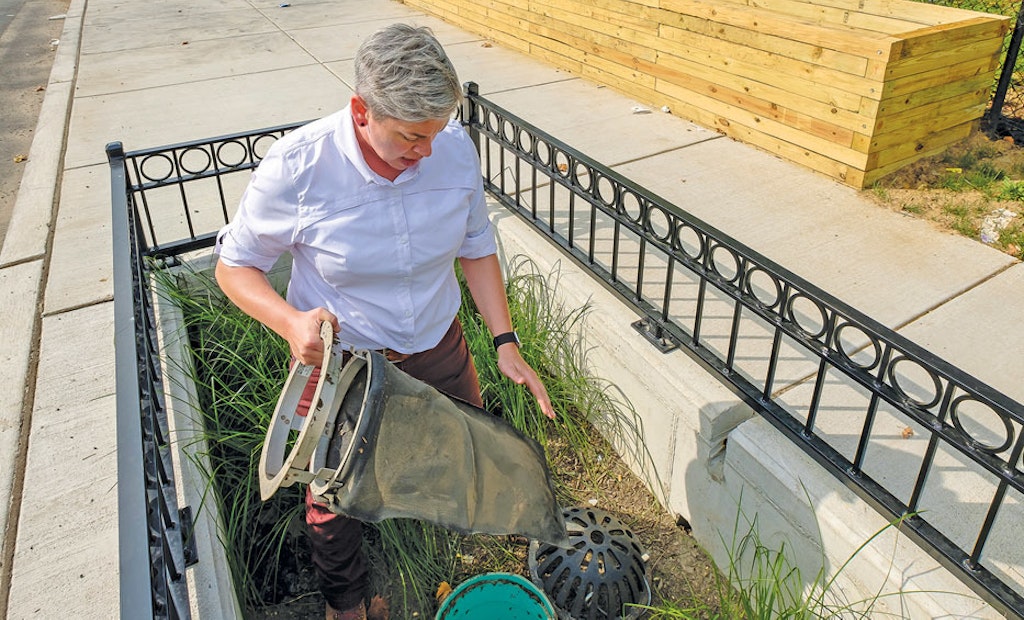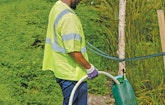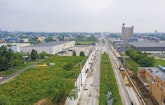
Meg Malloy pulls and checks a dome drain filter in the Columbus Park neighborhood. These sidewalk planters work to catch water from street and sidewalk runoff next to a community garden. Community gardens are spread throughout Philadelphia and are helping with stormwater control.
Interested in Stormwater?
Get Stormwater articles, news and videos right in your inbox! Sign up now.
Stormwater + Get AlertsPhiladelphia has a significant combined sewer overflow problem. To solve the problem, the Philadelphia Water Department came up with a solution so elemental that it just might work.
The comprehensive plan covers everything from sustainable home improvements to business credits and greening playgrounds, parks, streets and sidewalks. And the solution is simply to reduce the amount of water going into the system in the first place.
CSOs are a common problem, but Philadelphia’s situation is unique and the scope of its solution is unprecedented.
A unique challenge
Long before the city was covered in streets, sidewalks and skyscrapers, it was nothing but rolling hills, farmland, forest and streams — a lot of streams — as far as the eye could see. Like all developing cities, that land became less pristine as the population grew. The city’s creeks became convenient receptacles for just about anything anyone wanted to get rid of, including sewage, slaughterhouse refuse and industrial waste.
Not only were the creeks becoming heavily polluted, but they also stood in the way of development. During the mid-1800s, Philadelphia engineers tackled both problems by culverting the streams. One could say it was an “out of sight, out of mind” approach to the filth.
By the early 1900s, however, people started realizing that dumping sewage and other waste into the rivers was not sustainable and Philadelphia began a project to divert all those foul creeks into sewage treatment plants. These creeks became combined sewer systems that would only release directly into Philadelphia’s main waterways during heavy rain. It has been operating that way for the last century and will continue to work that way for the foreseeable future.
Today the PWD is responsible for approximately 3,000 miles of sewer, 79,000 stormwater inlets, three drinking water treatment plants, three sewage treatment plants, more than 25 pump stations, 175 CSO regulating chambers, 164 CSO outfalls, approximately 3,000 miles of water mains and more than 450 stormwater outfalls. The estimated annual CSO discharge is at about 16 billion gallons from 164 CSO point sources.
So, while many cities and towns have to deal with CSO events, PWD not only has to deal with rainwater runoff from buildings and streets, but naturally swelling streams as well. While the city does have a fair amount of green space in the combined sewer areas, developers are building on every square foot available. The result is very little private green space and even more runoff with nowhere to go but into the combined sewer systems. To put it simply, Philadelphia needs to absorb more of its rainfall into the land instead of directing it into the sewers, and they have a plan to do just that.
A new initiative
In 2011, Philadelphia launched its 25-year plan called the Green City, Clean Waters initiative. The ultimate goal is to improve water quality, and at the end of the 25 years, PWD is required to capture 85% of the pollutant loading discharged by the CSOs. However, on a year-by-year basis, CSO rates are too variable to use as a measure of success because of unpredictable weather events.
Instead, they measure incremental success through the achievement of greened acres. One greened acre is equivalent to 1 inch of managed stormwater from 1 acre of drainage area, or 27,158 gallons of managed stormwater.
The PWD green stormwater management systems are designed to capture the first 1 1/2 inches of rainwater. The more systems in place, the more greened acres and ultimately fewer CSO events. The department’s goal at the end of 25 years is to transform 34% of the combined sewer areas to pervious acres.
Joanne Dahme, general manager of public affairs for PWD, says they did consider taking the combined lines and making separate sanitary and storm lines, but it just wasn’t cost-effective or even practical in a dense, urban environment like Philadelphia. Sewer separation would require new stormwater laterals for every home and business on the block, and that involves disconnecting area drains, and downspouts at every property. Therefore, reducing the water flowing into the sewers was the most logical approach.
House by house
Philadelphia is home to over 1.5 million people, and residential roofs make up 20% of the city’s impervious cover. The PWD says that one key to success for this program may lie in the simplicity of smaller-scale stormwater management solutions on homeowners’ properties. The target is not to green every roof in the combined sewer area, but to capture the runoff before it goes into the sewers.
To chip away at the problem house by house, the PWD has developed a program they call Rain Check and hired the Pennsylvania Horticultural Society and the Sustainable Business Network of Greater Philadelphia to implement the program. Residents can use the Rain Check website to plug in a bit of information about their property and budget and they’ll get recommendations for several stormwater management options.
For example, residents can opt for a 55-gallon rain barrel to capture rainwater from their roof, and the city will pick up the entire tab. Alternatively, they might choose to plant a rain garden or install permeable pavers in their yards, in which case the city will cover 80% of the cost up to $2,000.
The Rain Check program does require residents who wish to participate to attend a workshop to learn about their different options. If they still want to proceed, an approved contractor will come out to their residence and conduct a site audit to make sure the project is feasible.
Dahme says downspout planters are the most widely implemented of the options available because they fit on almost any property, including the city’s iconic row homes. Permeable pavers are increasing in popularity, even though $2,000 doesn’t go a long way for a sizable property. The growing participation in the program is evidence that the PWD’s message is getting out, and residents are doing their part to ensure the health of their rivers and streams. In fact by the end of 2018, just six years after the program launched, close to 750 residential projects were completed.
Community partners
While homeowner participation plays a role in the success of the plan, Dahme says the best sites to help meet their greened acre milestones are public spaces such as playgrounds, recreation centers, parks and schools.
Dahme’s favorite project is also one of the department’s very first: the Columbus Square park.
“We weren’t known as the green entity or the entity that would be putting rain gardens in versus a new sewer. So, we had to change that mindset,” she says.
Getting community support was not easy on that first project. Street parking is difficult to come by in Philadelphia, and residents were not pleased to lose parking spots (legal or not) to the construction of gardens.
The department knew community engagement would be critical to the success of the project, so they started with the people most invested in the park — the Friends of Columbus Square. Once they had their support, they had an active partner in community outreach.
Educational events organized by PWD with the assistance of the Friends of Columbus Square were held at the park. At those events, residents would learn about the CSO problem and how they could not only mitigate the problem, but beautify their park at the same time.
The plan was to install stormwater management sidewalk planters just outside of the park. Storm management planters are different from regular planters in that they are slightly below grade. Each of the Columbus Square planters can take runoff from 8,000 square feet of street and sidewalk. The sidewalk runoff enters the planter through an open-mouth inlet, and the street water enters through a grate inlet.
During a rain event, a few inches of water will pond in the planters as it slowly trickles into the soil. Beneath the soil is a layer of stone that holds the water until the peak of the storm has passed and then releases it into the system at a rate the sewer can handle.
It is important to note that while there are commonalities to all sidewalk planters, rain gardens, bump-outs, etc., each system is designed specifically for the drainage area in which it is located.
While the PWD is ultimately responsible for maintaining the gardens, they encourage the community to help. For example, at Columbus Square, some schools have adopted the planters, and an outing to perform simple maintenance such as weeding and replanting becomes a science learning opportunity.
Continuing on the success of the planters, a rain garden was also installed in the park, creating an oasis everyone can enjoy right in the middle of the neighborhood.
Working together
The PWD works closely with the Streets Department and other departments to identify areas to retrofit with green stormwater infrastructure. If the Streets Department is tearing up a road for maintenance or improvements, that can be the perfect opportunity to incorporate stormwater infrastructure.
A significant project currently underway is the revitalization of a 2-mile stretch of the American Street corridor, an important hub of manufacturing from the late 1800s through the mid-20th century. This wide boulevard was once home to a Philadelphia & Reading Railroad route. Now, however, the train tracks running down the middle of the street sit unused and many of the buildings are abandoned, but that will soon change.
This area is experiencing a development boom and American Street is now a prime location. The Streets Department is leading the street revitalization project and is using a Transportation Investment Generating Economic Recovery, or TIGER, grant to make the area pedestrian- and bike-friendly. Some of that grant will pay for the removal of the old railroad tracks.
“That gave us the opportunity to install rain gardens where the tracks were located, which will manage approximately 1.4 million gallons of water every time it rains,” Dahme says.
In addition to the vegetated median bioswales, stormwater bump-outs will be incorporated into the new street design. The bump-outs will be composed much like the sidewalk planters at Columbus Square with a layer of stone topped with soil and plants. Inlets and curb cutouts will direct runoff into the structures, and whatever the soil and plants can’t absorb will be released into the sewer at a more manageable rate.
According to the PWD, aside from managing stormwater, bump-outs also help calm traffic; and when located at crosswalks, they provide a pedestrian safety benefit by reducing the street crossing distance.
Fee reductions
Private companies and institutions are responsible for about 16% of the city’s impervious cover. The city expects that a large number of buildings will be facing upgrades during the 25-year program, making them a prime target for incorporating green stormwater infrastructure into their plans. To sweeten the pot, the PWD created a new Parcel Based Billing initiative that ties impervious cover to the stormwater fee. Large private, nonresidential customers can earn credits in the stormwater portion of their bill for retrofitting their properties with stormwater management infrastructure.
PWD also requires stormwater management on new development and redevelopment sites through the stormwater regulations. The stormwater regulations have four main components: water quality, channel protection, flood control, and public health and safety release rate requirements.
These regulations apply to new development, redevelopment and demolition. Existing properties looking to lower their stormwater management bills can apply for grants to install stormwater features to manage runoff better.
Stormwater grants can cover up to 100% of the cost to design and construct stormwater retrofit projects on nonresidential properties. After a project is complete, the property owner then qualifies for lower stormwater charges on their monthly bill. PWD partners with the Philadelphia Industrial Development Corp. to award the grants, and just this year they increased the annual sum available from $15 million to $25 million.
Setting a standard
Thanks to the cooperation of city residents, businesses and public entities, the city is well on its way to achieving its 10-year goal of 2,100 greened acres by 2021. As of May this year, there are already 1,400 greened acres on the books. However, innovative plans of this magnitude can often be somewhat unpredictable.
PWD initially estimated the cost of the plan — the most extensive green stormwater infrastructure program ever envisioned in the U.S. — to be approximately $2.4 billion. Dahme says they recently revised that figure to $4 billion.
“I think the plan is harder to implement than we thought and mostly because of the cost. We didn’t have a set of designs we could just pull off the shelf.” The infrastructure has to be designed uniquely to the situation where it’s being installed, but PWD is attempting to create design templates for reoccurring cases.
“We were really, really conservative when we started. We wanted to ensure we didn’t cause any flooding to any property or cause any problems,” Dahme says. While PWD regularly exchanges ideas with other utilities and municipalities, they were the first to do something of this nature at this scale. There was no one who could provide advice or share lessons learned.
“It would’ve been hard for us not to do it the way we did it, because we were one of the first and so we did have to be the innovator, and we didn’t have much of a choice about that.”
The PWD will be doing a thorough review to see how they can best bring the costs down moving ahead.
What has been a challenge for Philadelphia doesn’t have to be for other municipalities looking to implement a similar program. Utilities and government representatives from all over the U.S. and abroad come to Philadelphia to see what PWD is accomplishing.
The Water Department doesn’t just accommodate these requests; they encourage them. If you are interested in learning more about the Green City, Clean Waters initiative, visit the PWD website. If what you see inspires you, contact the department to request a tour.
A stormwater pioneer
The Children’s Hospital of Philadelphia was named the 2017 Stormwater Pioneer for outstanding stormwater management in the newly constructed Buerger Center for Advanced Pediatric Care.
The awards are a way for the Philadelphia Water Department to recognize innovative stormwater management on private property.
The Buerger Center includes a 2.3-acre public plaza that sits on top of the parking garage. Within the plaza are more than 35,000 square feet of vegetation that filters rainwater and promotes evapotranspiration of the runoff.
There is also a 14,000-square-foot rooftop garden on the sixth floor of the center that is accessible only to patients, families and staff. Interestingly, this space overlooks the Schuylkill River, which is one of the bodies of water protected in part by the hospital’s stormwater management features.
In addition to the gardens, the hospital also implemented a tank storage system to manage overflow from the garage structure. These tanks serve two purposes: The first is to collect water and slowly release it into the sewer system, and the second is to provide irrigation for the plaza and rooftop gardens.
All in all, the stormwater management system at the Buerger Center is expected to capture approximately 105,000 gallons of water during a 1-inch rainfall event.













